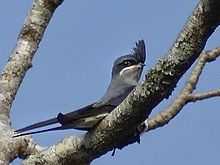Crested treeswift
| Crested treeswift | |
|---|---|
 | |
| Conservation status | |
| Scientific classification | |
| Kingdom: | Animalia |
| Phylum: | Chordata |
| Class: | Aves |
| Order: | Apodiformes |
| Family: | Hemiprocnidae |
| Genus: | Hemiprocne |
| Species: | H. coronata |
| Binomial name | |
| Hemiprocne coronata (Tickell, 1833) | |
The crested treeswift (Hemiprocne coronata) is a kind of tree swift. The tree swifts are aerial near passerine birds, closely related to, but distinct from the true swifts. They are restricted to southeast Asia and Australasia. It was formerly considered conspecific with its eastern relative, the grey-rumped treeswift (Hemiprocne longipennis), but they do not interbreed where their ranges overlap.
_in_Kawal_WS%2C_AP_W_IMG_2133.jpg)
Description
The crested treeswift is a large slender bird at 23 cm (9 in) length. This species is dove grey above and white below. The long swept-back wings are a darker grey above. This treeswift has a crest and a long, deeply forked tail. The adult male has orange sides to its face. Young birds have a dark grey head and wings, but the rest of the soft plumage is much streakier than that of the adults.
The call of this species is a harsh kee-kyew.
Distribution and habitat
The crested treeswift is a common resident breeder from the Indian subcontinent. It is found in India, Sri Lanka, Bhutan, Bangladesh, Nepal, Myanmar, Thailand, Vietnam, Cambodia, Laos and China.[1] These are birds of open woodland and deciduous forests. They are also found in open areas near trees and in parks and gardens. Most birds live in areas with altitudes of no more than 365 m (1,198 ft). [2]
Behaviour
The crested treeswift builds a tiny nest which is glued to an exposed tree branch. It lays one blue-grey egg, which is incubated by both sexes. The nest is so small that incubating birds perch upright on the edge of the nest, covering the egg with their underparts feathers.
The crested treeswift feeds in the air, living on the insects it catches in its bill. It looks more like a swallow in flight than a swift, but is unrelated to that group. Unlike the true swifts, the treeswifts readily rest on high bare tree branches.
Status
The crested treeswift has a very large range, the population size seems stable and it is considered relatively common. For these reasons, the IUCN has listed it as being of "Least Concern".[1]
References
- ↑ 1.0 1.1 1.2 BirdLife International (2012). "Hemiprocne coronata". IUCN Red List of Threatened Species. Version 2013.2. International Union for Conservation of Nature. Retrieved 26 November 2013.
- ↑ "Tree Swifts: Hemiprocnidae - Crested Tree Swift (Hemiprocne coronata): Species Account". Retrieved 2013-12-20.
- Birds of India by Grimmett, Inskipp and Inskipp, ISBN 0-691-04910-6
- Swifts by Chantler and Driessens, ISBN 1-873403-83-6
Gallery
-
_in_Kawal_WS%2C_AP_W_IMG_2134.jpg)
Female & male in Kawal Wildlife Sanctuary, India.
-
_in_Kawal_WS%2C_AP_W_IMG_2132.jpg)
Female & male in Kawal Wildlife Sanctuary, India.
-
_in_Kawal_WS%2C_AP_W_IMG_2115.jpg)
Male in Kawal Wildlife Sanctuary, India.
-

Crested Treeswift Male in flight, Thattekad, Kerala, India
-

Crested Treeswift Female in flight, Thattekad, Kerala, India
